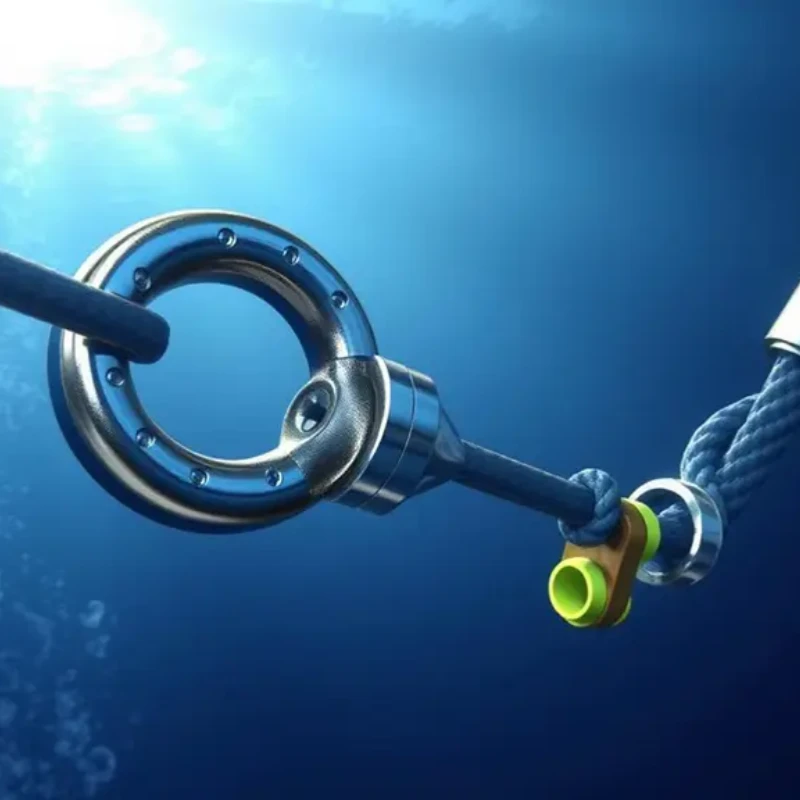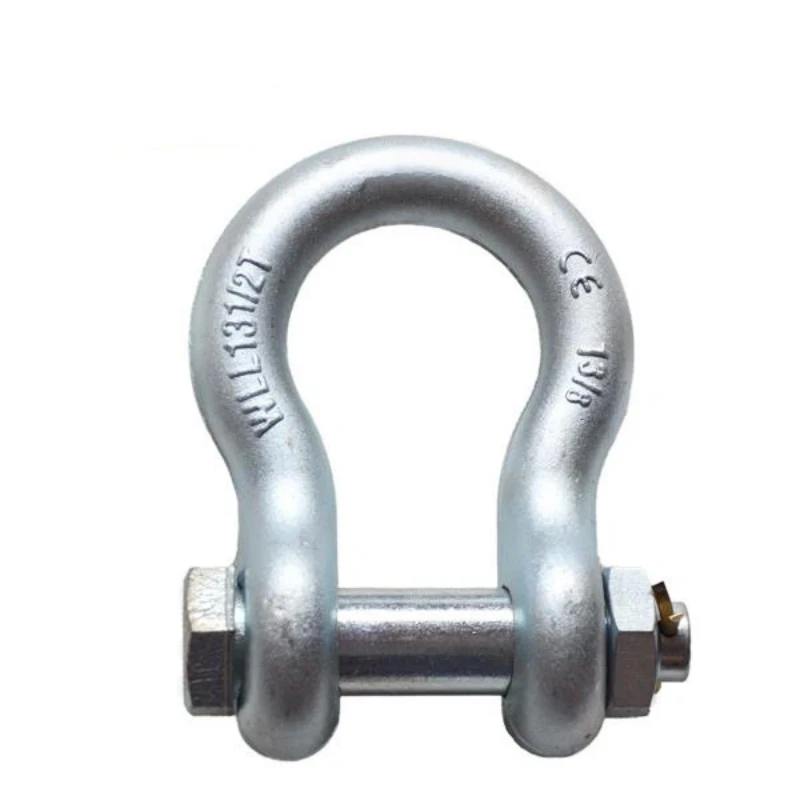When you select d-shackles and safety chains for caravans, you want to ensure both legality and safety for every journey. Not all towing safety gear meets strict standards, so you must choose certified products that comply with current regulations.
Legal requirements define the minimum, while best practices help you protect your caravan and everyone on the road. Powerful Machinery provides trusted, certified solutions to meet your towing needs.
Key Takeaways
Always use safety chains that meet Australian standards for your caravan’s weight. This ensures legal compliance and enhances safety on the road.
Select D-shackles that are marked with the manufacturer’s name and working load limit. This guarantees they are suitable for towing and helps prevent accidents.
Inspect your safety chains and D-shackles before every trip. Regular checks for wear or damage can prevent unexpected failures during towing.
Cross your safety chains under the drawbar when towing. This simple step adds an extra layer of protection if the coupling disconnects.
Choose certified products from trusted manufacturers like Powerful Machinery. Certified gear meets strict safety standards and provides peace of mind.
Legal Requirements
Safety Chains Standards
You must use safety chains that meet strict Australian standards when towing a caravan. The legal requirement states that every trailer up to 3,500 kg maximum gross mass (ATM) must have safety chains permanently attached to the trailer.
You cannot use shackles to attach the chain to the drawbar for these trailers. Instead, you must bolt or weld the chain directly to the trailer frame. For trailers over 3,500 kg ATM, the chain-to-drawbar attachment must not be welded or deformed.
The table below outlines the requirements for safety chains and suitable rated d shackles for caravans based on trailer weight:
Trailer ATM (kg) | Chain size classification (AS 4177.4-2004) | Chain marking (AS 4177.4-2004) | Suitably rated D shackle size (AS 2741-2002) Grade ‘S’ or ‘6 dee’ or ‘6 bow’ | Minimum proof load strength (kN) chain/shackle |
|---|---|---|---|---|
Up to 1,000 | 1,000. At least one chain must be used | 4177-10 | 6mm S WLL 0.5T | 4.9 / 9.9 |
Up to 1,600 | 1,600. At least one chain must be used | 4177-16 | 6mm S WLL 0.5T | 7.9 / 9.9 |
Up to 2,500 | 2,50.0 At least one chain must be used | 4177-25 | 8mm S WLL 0.75T | 12.3 / 14.8 |
Up to 3,500 | 3,500 Two safety chains must be used | 4177-35 | 10mm S WLL 1.0T | 17.2 / 19.7 |
You should always cross the safety chains under the drawbar. This practice helps prevent the coupling from hitting the ground if it disconnects. You must also ensure that the chains are stamped with the correct standard, such as ‘4177-XX’, and that you use the correct number of chains for your trailer’s weight.
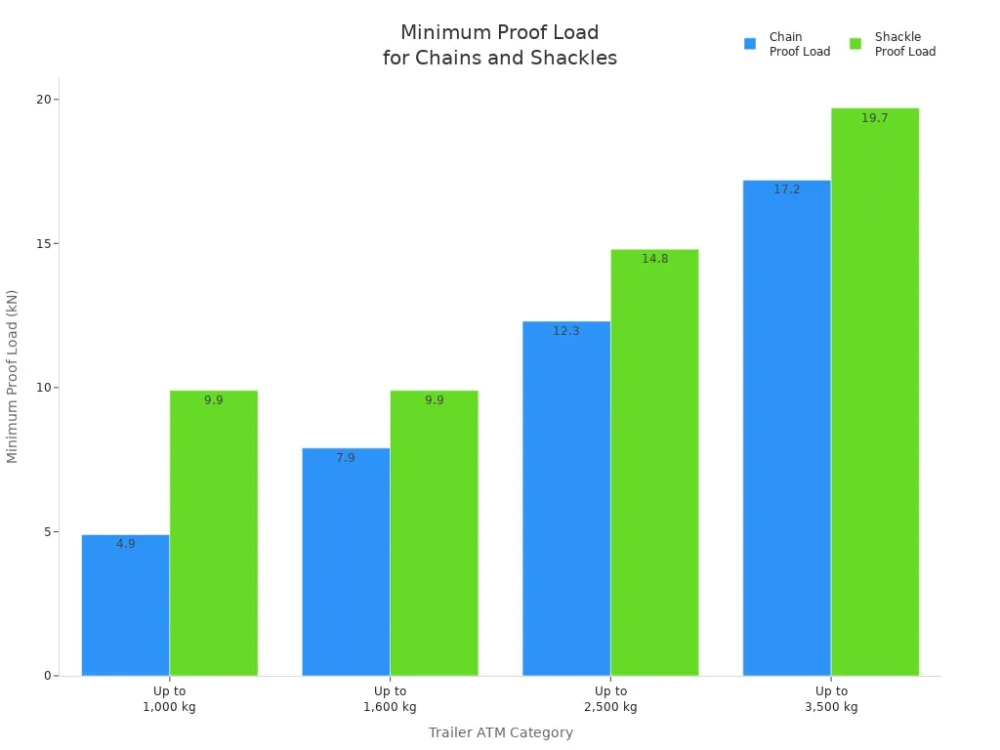
Tip: Replace your safety chains every few years. Road contact and wear can weaken the chain, reducing safety.
D-Shackles Regulations
You need to pay close attention to the legal specifications for the shackles when connecting safety chains. While current legislation does not mandate that you use certified d-shackles for caravans, industry best practice recommends using shackles that comply with Australian Standard AS 2741-2002.
These shackles should have a break load limit at least 1.5 times greater than your trailer’s ATM. Each d-shackle must be permanently marked with the manufacturer’s name, quality grade, working load limit, and identification marking.
The following table summarizes the main requirements for d-shackle selection:
Requirement | Specification |
|---|---|
Shackles must be stamped | Yes |
Rated for towing | Yes |
Working Load Limit (WLL) | Must be marked |
Shackle grade | ‘S’ or ‘6’ |
Working load limit | 1000kg |
Shackle diameter | 10mm |
Type of shackle | Bow or D-Shackle |
You should always inspect your d-shackle before use. Look for any signs of damage or wear. Only use rated D shackles that are stamped and clearly identifiable as suitable for your caravan and towing vehicle combination. This approach ensures safety and compliance with industry recommendations.
Note: There are no fines or penalties for using unrated d-shackles, despite rumors and misinformation. However, using rated and stamped shackles remains the safest choice.
Compliance Across States
You must follow national and state-specific requirements for towing safety. All states in Australia require safety chains under ADR 62/02 and the Road Vehicle Standards Act (RVSA).
You must select chains appropriate for your trailer’s weight category. Non-compliance can lead to insurance issues or fines if your safety chains do not meet the legal requirements.
Standard | Description | Requirements |
|---|---|---|
AS 4177.4 | For trailers up to 3.5 t ATM | Chains must be stamped with ‘4177-XX’, 1 chain required up to 2.5 t ATM, and 2 chains between 2.5 t and 3.5 t ATM. |
AS 2321 | For trailers over 3.5 t ATM | Must be Grade T steel, no welding allowed, and breaking load must meet or exceed the specified minimum. |
You will find that some states offer guidelines for selecting suitable shackles, but there is no uniform legal requirement for D-shackles. Always check your local road authority’s advice before towing. Following these requirements ensures your caravan setup meets both national legislation and best practice for safety.
Technical Standards
AS 2741-2002 for D-Shackles for Caravans
You must understand the Australian standard AS 2741-2002 when selecting d shackles for caravans. This standard sets out the minimum requirements for shackles used in lifting and towing. It ensures that each d-shackle meets strict criteria for strength, size, and identification.
You should always look for shackles marked with the grade, working load limit, and manufacturer’s name. The table below summarizes the main requirements:
Requirement | Specification |
|---|---|
Shackle grade | S or 6 |
Working load limit | 1000kg |
Shackle diameter | 10mm |
Type of shackle |
You protect your caravan and others on the road by choosing shackles that comply with this Australian standard. Proper markings and correct sizing help prevent failures during towing.
Chain Grades and Ratings
Chain grades play a key role in towing safety. The Australian standard requires you to use chains that match your trailer’s weight. Higher-grade chains provide greater strength and durability. You must select the right grade to avoid equipment failure. Consider these points:
Chain grades determine the strength and load capacity of your safety chains.
Higher-grade chains handle heavier loads and improve safety margins.
Always match the chain grade to your trailer’s weight category.
Trailer Weight Category | Safety Chain Requirement | Relevant Australian Standard |
|---|---|---|
Up to 2.5 tonnes ATM | At least one safety chain complying with AS 4177.4-1994 or AS 4177.4-2004 | AS 4177.4-1994, AS 4177.4-2004 |
Over 2.5–3.5 tonnes ATM | Two safety chains of 3500 kg complying with AS 4177.4-1994 or AS 4177.4-2004 | AS 4177.4-1994, AS 4177.4-2004 |
Over 3.5 tonnes ATM | Two safety chains made from steel with a minimum 800 MPa breaking stress conforming to Grade T chain | AS 2321-1979, AS 2321-2006 |
You should always use a safety chain in addition to the shackle for extra protection.
Powerful Machinery Product Certifications
Powerful Machinery provides shackles and chains that meet or exceed the Australian standard and other international benchmarks. You can trust their products because they carry certifications such as ISO9001, TUV Rheinland, and ASTM.
These certifications show that each product has passed rigorous testing for strength and safety. When you choose Powerful Machinery, you ensure that your towing setup meets the highest standards for reliability and compliance.
Tip: Always check for certification markings on your shackles and chains before installation. Certified products give you peace of mind and help you meet legal requirements.
Product Selection Guide
Choosing D-Shackles and Safety Chains for Caravans
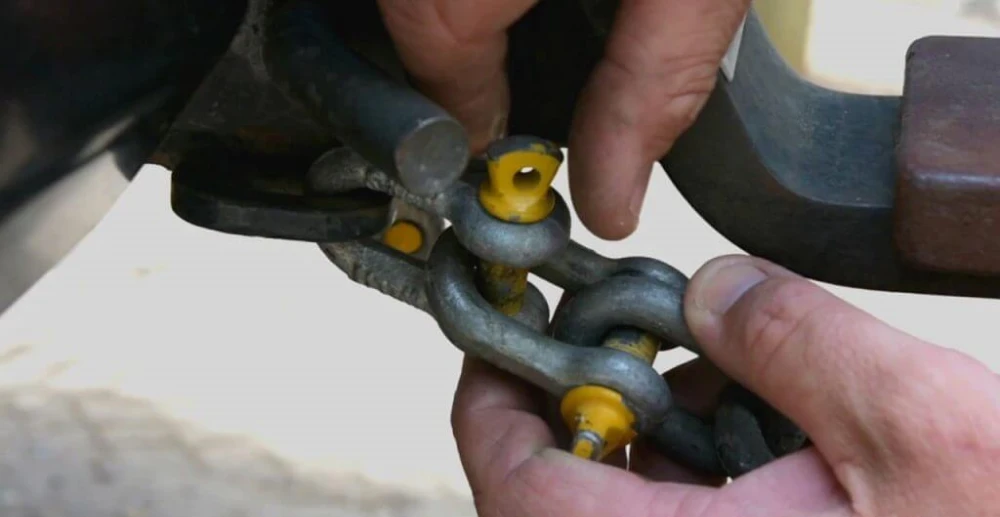
Selecting the right d-shackles and safety chains for caravans is essential for safe and legal towing. You should always start by checking your caravan’s Aggregate Trailer Mass (ATM).
This figure determines the minimum strength and size requirements for both shackles and chains. Use the following table to guide your selection process:
Requirement | Details |
|---|---|
Safety Chain Requirement | At least one safety chain for trailers with an ATM up to 2500kg; two for greater capacity. |
Strength Requirement | Safety chains must meet the strength requirements relative to the ATM or caravan mass. |
Manufacturer Responsibility | Compliance with Australian Standards is the manufacturer’s responsibility. |
You should also ensure that the breaking strain of any shackle you use exceeds 1.5 times the ATM of your caravan. This margin provides a crucial safety buffer during towing. For most caravans, you need shackles that comply with AS 2741-2002 standards, especially for securing safety chains up to 3500kg.
When choosing d-shackles and safety chains for caravans, consider these key factors:
Load capacity must match or exceed your caravan’s ATM.
Use only shackles marked with grade ‘S’ or ‘6’.
The working load limit should be at least 1000kg.
Shackle diameter should be 10mm.
Both Bow and D-Shackles are suitable for connecting safety chains.
Tip: Always inspect your d-shackles and safety chains before every trip. Replace any component that shows signs of wear or damage.
Stainless Steel Shackles by Powerful Machinery
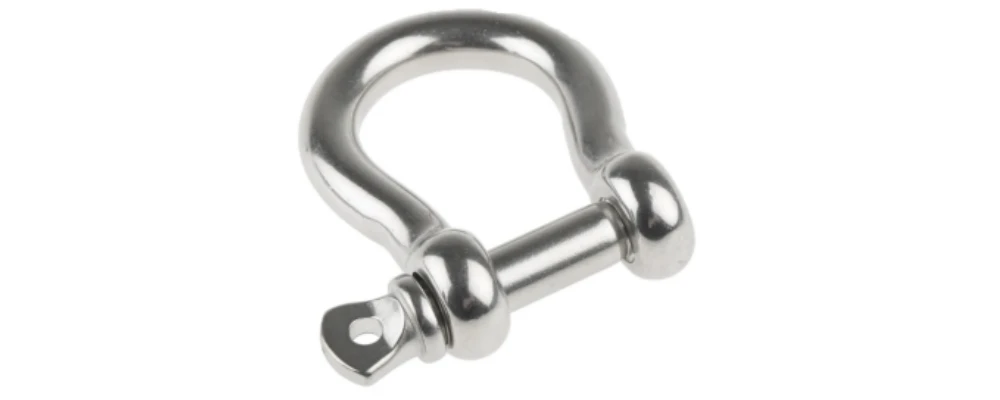
Powerful Machinery offers a range of stainless steel shackles designed for durability and reliability in caravan towing. You benefit from using these shackles because they resist rust and corrosion, making them ideal for all environments, including coastal and humid regions.
Their robust construction ensures outstanding longevity, so you can trust them for repeated use in demanding conditions.
Key advantages of Powerful Machinery’s stainless steel shackles include:
Exceptional resistance to rust and corrosion, even in harsh weather.
High durability and long service life, reducing the need for frequent replacements.
Consistent performance that maintains safety and reliability over time.
You can choose from various types, such as screw pin D shackles and bolt-type shackles, to suit your specific towing setup. Each shackle meets or exceeds international standards, giving you peace of mind on every journey. For more details, visit Powerful Machinery Stainless Steel Shackles.
Matching Size and Load
Matching the correct size and load rating for d-shackles and safety chains for caravans is critical for safety. Use the table below to determine the recommended chain size for your trailer’s ATM:
Trailer ATM (tonnes) | Chain Size (mm) |
|---|---|
Up to 1.0 | 6.3 |
Up to 1.6 | 8 |
Up to 2.5 | 10 |
Up to 3.5 | 13 |
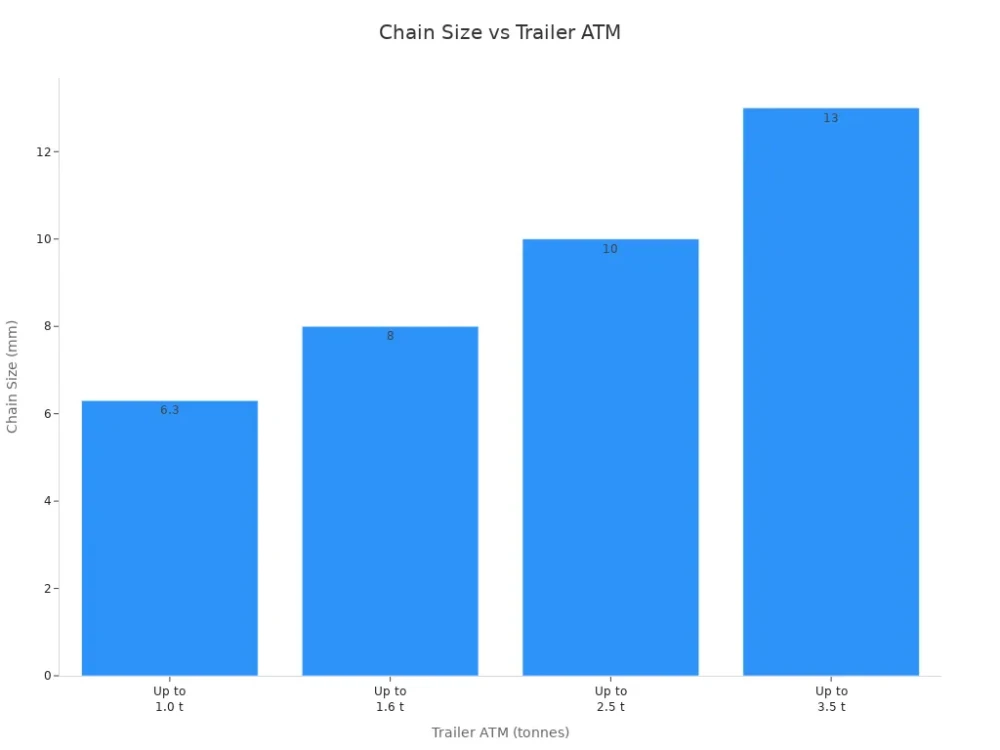
When selecting d-shackles for caravans, always ensure:
Shackle grade is ‘S’ or ‘6’.
Working load limit is at least 1000kg.
Shackle diameter is 10mm or more.
Both Bow and D-Shackles are acceptable for connecting safety chains.
The shackle’s breaking load must exceed the chain’s rating and be at least 1.5 times the ATM.
You can also find larger shackles, such as an 11mm D shackle with a working load limit of 1500kg, suitable for towing heavier loads. Always connect the shackle to the fixed part of the tow bar for maximum safety.
Note: The Caravan Industry Association of Australia recommends following AS 2741-2002 for shackles. This standard, while designed for lifting, provides clear guidelines for towing safety.
By following these steps and using certified products like those from Powerful Machinery, you ensure your d-shackles and safety chains for caravans meet all requirements for safe and compliant towing.
Installation and Fitment
Attachment Points
Proper attachment is the foundation of safe caravan towing. You must connect safety chains to approved points on both the trailer and the tow vehicle. For trailers up to 2.5 tonnes, use a single attachment point on the chassis rail. For trailers over 2.5 tonnes, two attachment points are required.
Always ensure the chain is permanently connected to the trailer. Use only manufacturer-approved devices for this purpose. The table below summarizes best practices for attachment:
Requirement | Details |
|---|---|
Safety Chain for Trailers up to 2.5t | Single chain, rated, attached to chassis rail by approved device |
Safety Chains for 2.5t to 3.5t | Two chains, welded or fixed to the chassis rail |
Safety Chains for 3.5t to 7.2t | Grade 80, attached with a high tensile pin |
Attachment Points | One for up to 2.5t, two for over 2.5t |
Permanent Connection | Chains must be permanently connected to the trailer |
Tip: Always use the correct pin for your d-shackle and tighten it fully before every trip.
Crossing Safety Chains
Crossing your safety chains under the drawbar is a simple step that adds a layer of protection. If the coupling disconnects, the crossed chains will catch the drawbar and prevent it from hitting the ground.
You should cross the chains so they form a cradle. This method works for both single and dual chain setups. Make sure the chains have enough slack for turning, but not so much that they drag on the road.
Chain Extension Methods
Sometimes, you may need to extend your safety chains to reach the tow bar. Use only rated shackles or approved extension links for this purpose. Avoid using makeshift solutions, as they can compromise safety. Always inspect your extension hardware for signs of wear or damage.
Remove any questionable shackles immediately. Prevent shock loading by driving smoothly and avoiding sudden stops or starts. This practice helps maintain the integrity of every attachment and keeps your caravan secure during towing.
Use the original manufacturer-supplied pin and secure it tightly.
Avoid sudden forces that could exceed the rated capacity of your hardware.
Inspect all attachments regularly and replace damaged components.
Note: Proper installation and regular checks help you avoid common errors and ensure a safe journey every time.
Maintenance
Inspecting Safety Chains
You must inspect safety chains regularly to maintain a secure towing setup. Begin by checking each link for signs of rust, cracks, or deformation. Look for worn areas where the chain rubs against metal surfaces. If you notice any damage, replace the chain immediately.
Use a flashlight to examine hard-to-see spots. You should also verify that the chain markings remain visible and legible. A clear stamp confirms compliance with Australian standards.
Tip: Schedule inspections before every trip and after driving on rough terrain. Early detection prevents unexpected failures.
Replacing D-Shackles for Caravans
You need to replace d-shackles when you see wear, bending, or corrosion. Remove the shackle and inspect the pin for straightness and thread integrity. If the pin feels loose or the threads show damage, install a new shackle. Always choose a replacement that matches the original grade and size.
Powerful Machinery offers certified shackles that meet strict industry standards. You can rely on these products for consistent performance and safety.
Steps for replacing d-shackles:
Remove the old shackle using the correct tool.
Inspect the attachment point for damage.
Select a certified replacement with the same rating.
Install and tighten the new shackle securely.
Routine Safety Checks
Routine safety checks keep your caravan ready for towing. Create a checklist to track inspection tasks. Review the condition of safety chains, shackles, and attachment points.
Confirm that all connections remain tight and free from rust. Test the security of each component by gently tugging on the chain and shackle. Record the inspection date and any actions taken in a logbook.
Maintenance Task | Frequency | Action Required |
|---|---|---|
Inspect safety chains | Before trips | Check for damage |
Replace d-shackles | As needed | Use certified products |
Tighten connections | Monthly | Ensure a secure fit |
Note: Consistent maintenance extends the life of your towing equipment and protects your investment.
Compliance Checklist
Quick Reference
You can use this quick reference checklist to confirm your caravan’s towing setup meets all legal and safety requirements:
Item | Requirement | Checked? |
|---|---|---|
Safety Chains | Correct grade and size for trailer ATM | ☐ |
Chain Attachment | Permanently fixed to trailer (no shackles) | ☐ |
Number of Chains | One for up to 2.5t, two for 2.5–3.5t ATM | ☐ |
D-Shackles | Marked with grade, WLL, and manufacturer | ☐ |
Shackle Size | Minimum 10mm diameter, WLL at least 1000kg | ☐ |
Shackle Type | D or Bow, not carabiners or sling hooks | ☐ |
Certification | Meets AS 2741-2002 and other relevant standards | ☐ |
Chain Crossing | Chains crossed under the drawbar | ☐ |
Regular Inspection | Chains and shackles checked for wear or damage | ☐ |
Tip: Print this checklist and keep it in your caravan. Review it before every trip to ensure compliance and safety.
Common Mistakes
Many caravan owners make simple but critical mistakes with D-shackles and safety chains. You might use the wrong equipment, such as bow shackles, sling hooks, or carabiners, for attaching your trailer.
These items do not meet safety regulations and can put your caravan at risk. Always choose shackles and chains that carry the correct markings and certifications.
Confusion often arises because government guidelines recommend best practices, but you do not face a legal obligation to follow every guideline. This can lead you to believe that any connection device is acceptable.
In reality, only certified D-shackles and properly rated safety chains ensure your towing setup remains safe and compliant.
⚠️ Alert: Never substitute uncertified hardware for rated shackles or chains. Using the wrong equipment can result in towing and may void your insurance.
Stay vigilant, follow the checklist, and use only certified products like those from Powerful Machinery to keep your caravan and everyone on the road safe.
Conclusion
You ensure safe caravan towing by choosing the right D-shackles and safety chains, installing them correctly, and maintaining them regularly. Always select certified products like those from Powerful Machinery to meet legal and technical standards.
Inspect your equipment before every trip and replace any worn parts. Staying vigilant protects your caravan, your passengers, and everyone on the road.
Tip: Trust certified gear and follow best practices for peace of mind on every journey.
FAQ
What size D-shackle should you use for caravan towing?
You should use a D-shackle with a minimum 10mm diameter and a working load limit of at least 1000kg. Always check the manufacturer’s markings for grade and certification.
Can you use stainless steel shackles for towing caravans?
Yes. Stainless steel shackles resist corrosion and provide reliable strength. Powerful Machinery’s stainless steel shackles meet industry standards and work well for caravan towing in all environments.
How often should you replace safety chains and D-shackles?
Inspect your safety chains and D-shackles before every trip. Replace them if you see rust, wear, or deformation. Regular checks help you avoid unexpected failures.
Are all D-shackles legal for caravan towing in Australia?
Only use D-shackles marked with grade, working load limit, and manufacturer’s name. Unmarked or unrated shackles may not meet Australian standards and could risk your safety or insurance coverage.

